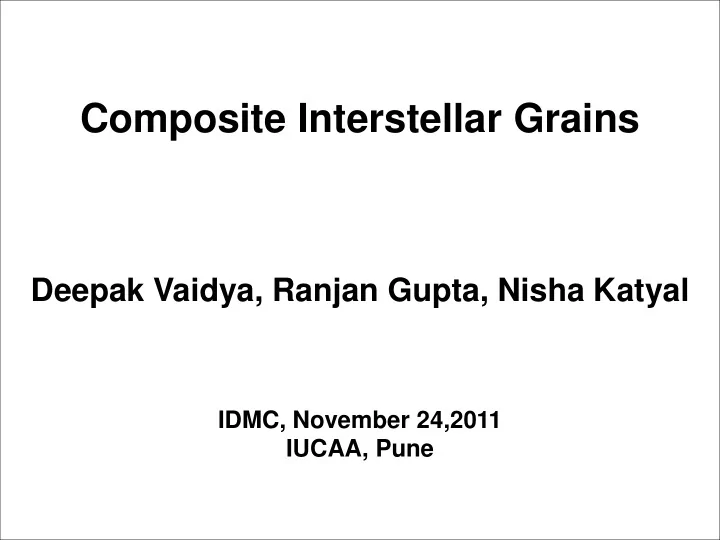

Composite Interstellar Grains Deepak Vaidya, Ranjan Gupta, Nisha Katyal IDMC, November 24,2011 IUCAA, Pune
Plan of the talk Dust Grain Models : Constraints Light Scattering : Basic Extinction curves Composite Grain Model Model Results : Extinction curves Comparison with Observations Conclusions ______________________________________________ _ IR Emission from Dust
Dust Grain Models should be consistent with the Observed Interstellar Extinction, Polarization and elemental abundances
A dust grain model, which simultaneously explains the observed interstellar extinction, polarization, IR emission and the abundance constraints is required.
The spherical grain model, consisting spherical silicate and graphite particles, with a power law size distribution, called MRN model, is the most commonly used dust model, to interpret the observed interstellar extinction.
Spherical bare/solid Silicate and Graphite Grains, (MRN model, 1977) – Model provides an excellent fit to the average interstellar extinction curve….. However, MRN model requires about ~ 350 carbon (C/H) ppm, ~ 34 Silicon (Si/H) ppm whereas , the ISM values, derived from observations; for C/H~ 110 and Si/H~20
It is highly unlikely that interstellar grains are spherical in shape or homogeneous in composition and structure. Dust grains flowing out of stars are more likely to be nonspherical and inhomogeneous-porous,fluffy and composites of very small particles glued together, due to grain-grain collisions, dust-grain interactions and various other processes. The interplanetary particles collected from space are nonspherical and composites. Moreover, interstellar polarization that accompanies extinction requires that the interstellar grains must be non-spherical and aligned. The elemental abundances derived from the observed interstellar extinction do not favour the homogeneous composition of the interstellar grains.
Light Scattering Spherical Grains, (Mie 1908) Non-spherical Grains – Cylinders (Kerker, Greenberg 1960) Spheroids (Asano 1975) Homogeneous Grains – solid/bare grains single component/composition Inhomogeneous Grains – Porous,Fluffy, Composite Grains- multi – component/- composition - EMT, DDA
Light Scattering Scattering /Efficiency Parameters : Q sca , Q abs , Q ext ; Qext = Qsca + Qabs X=2πa /λ , dimensionless size parameter In order to calculate efficiency factors, one needs to solve Maxwell’s electromagnetic wave equations for various boundary conditions.
Discrete Dipole Approximation(DDA) There is no exact theory to calculate the scattering and absorption of light by irregular and inhomogeneous (porous,fluffy,composite)particles. Hence, we use approximate methods; viz. DDA(Draine 1988), or Effective Medium Theory(EMT). The DDA replaces a solid particle by an array of N point dipoles. When a grain is exposed to an electromagnetic wave, each dipole responds to the radiation field of the incident wave as well as to the fields of the other dipoles.
Validity criteria for DDA: (1) I mkd I<1, m-refractive index k-wavenumber d-distance between dipoles (2) ‘d’ should be small; (N-number of dipoles should be sufficiently large)
Composite Grain Model: A computer code is developed to generate the Composite Grain Model.It consists of a host Silicate spheroid and Graphite inclusions. We have studied composite grain models with silicate spheroids containing number of dipoles N=9640,14440,25896 and volume fraction f=0.1,0.2 and 0.3 of graphite inclusions.
N=9640
– no. of incl.=11
Using DDA, we have calculated extinction efficiency Qext in the spectral region 0.1 – 3.4 µ m for the composite grains and studied the variation of the extinction efficiency with volume fraction of the inclusion.
Best Fit Extinction carves
Best Fit Parameters (a = 0.005 – 0.250 m) (Vaidya, Gupta, Snow 2007)
IUE Data
Composite model fits, with IUE observed stars
Composite model fits, with IUE observed stars
Porous model fits, with IUE observed stars
Porous model fits, with IUE observed stars
Linear Polarization
SUMMARY: These results on the composite grain models show that the inhomogeneity in the grains modify the extinction properties of the grains. Composite Grain Model curves fit the observed extinction reasonably well, however’ model curves with other materials (amorphous carbons, silicon carbide , PAHs)are needed for better fit in the uv region (<0.2µm) Model polarization curves in the UV are also required. Estimated cosmic abundances, C/H~160 and C/H~25 are still above the ISM values , C/H~110 and S/H~20 Models should be consistent with IR emission. A synthetic approach (theoretical models + lab study) is required.
Acknowledgements J. N. Desai (PRL) Harish Bhatt (IIA) B. G. Anandarao (PRL) Peter Chylek (Dalhousie University) Steven Dobbie (Leeds University) T. P. Snow (Unversity of Colorado) Ranjan Gupta, Nisha Katyal (IUCAA)
Recommend
More recommend